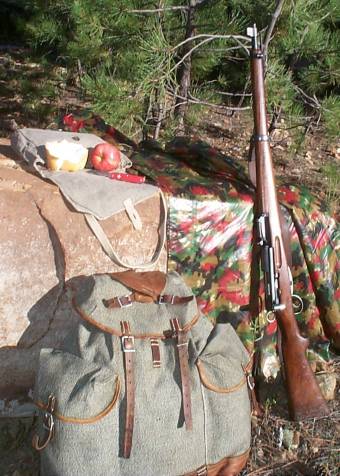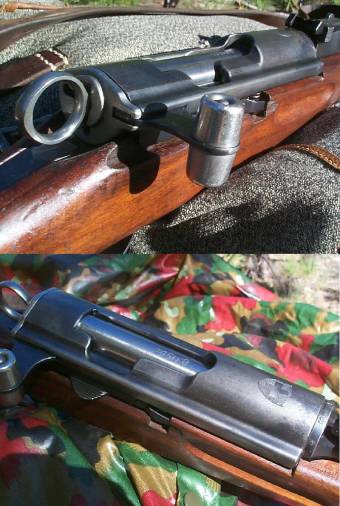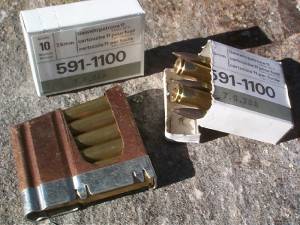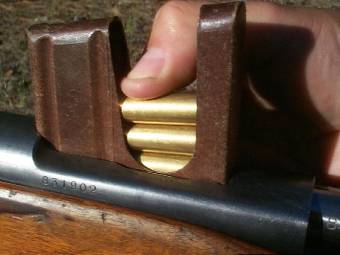
| Articles | Documents | Equipment | Events | Links | Membership | Miscellaneous | Scrapbook | Targets | What's New |
| Little Swiss Miss | August 2003 | ||||
| Dan Martinez
| |||||
|
Legend states that not long after the three states pledged their mutual assistance pact, the Habsburgs sent a new sheriff by the name of Hermann Gessler to the town of Altdorf in Uri. As a symbol of his authority, Gessler had constructed a pole in the center of town, on which he placed his hat. It was commanded that all townsfolk who passed by the pole were to bow in respect. It is not clear whether the man from the nearby town of Bürglen did not know of the decree, or whether he purposely chose to flout the law. Regardless, the man was immediately arrested when he passed by without bowing. But since Gessler was in a playful mood, the man was given one chance to save his life. Since the man was known as an expert with a crossbow, Gessler offered the man his freedom if he could shoot an apple from off the top of his son’s head. If he refused, both he and his son would be executed. The boy was tied to the pole and an apple was placed on his head. The man put one arrow in his quiver and nocked another in his crossbow. He fired and his aim was true. Gessler was quite impressed by this show of excellent marksmanship. He then made the mistake of asking why the man had placed a second arrow in his quiver. The man from Bürglen looked Gessler straight in the eye and told him that if the first arrow had struck his son, then the second arrow would have been for him. Well this just pissed Gessler off all over again. His previous offer to the man from Bürglen was revoked and the man was sentenced to the dungeon for life. However, the trip to the castle dungeon involved a long boat ride across Lake Lucerne. During the trip, a fierce storm arose and the man managed to escape. Simply escaping was not enough. One dark night, not long after the escape, the man found Gessler walking alone on a deserted lane. An arrow zipped out of the darkness and found Gessler’s heart. Over time, more states, or cantons, joined the Swiss confederation. Switzerland has three official languages: German, French, and Italian. German is exclusively spoken in 17 of the 26 Swiss cantons, French in four, and Italian in 1. The remaining cantons are multi-lingual. Over the centuries, however, the legend of William Tell has served to unite and inspire all Swiss to remain forever free from outside interference. It also underpins the Swiss tradition of excellence in marksmanship. It actually wasn’t until the 1500’s though, that Switzerland’s famous doctrine of strict neutrality began to take form. Switzerland’s neutrality was first formally recognized in 1648 with the signing of the Treaty of Westphalia. When it comes to military firearms, the Swiss have always gone their own way. The Swiss are well-known for fine engineering and high standards of craftsmanship. When you mix those traits in with their strong belief in neutrality, you can understand why the Swiss have never depended on the equipment of any other nation to maintain their national defense. When the smokeless era began, it was Colonel Eduard Rubin of the Swiss army who invented the jacketed bullet as the solution to the problem of high velocity accuracy with the new smokeless powder. Working with Colonel Rudolph Schmidt, Rubin developed the 7.5mm Swiss cartridge which was introduced in 1889 along with the first production version of the Schmidt-Rubin straight-pull bolt action rifle. Updated to its modern form in 1911, the Swiss 7.5mm cartridge remained the standard until 1983 when the Swiss finally adopted a new cartridge very similar to the 5.56mm NATO (in fact, it’s interchangeable). The early version of the 7.5mm Swiss cartridge used a bullet with a diameter of .304 inch. Since the 1911 update however, Schmidt-Rubin rifles and the ammo have been made with a true .308 inch diameter, despite the 7.5 mm designation. Switzerland has a unique military system. Theirs is a true militia system which our founding fathers intended to emulate when our nation was born. Every male citizen, upon reaching the age of 20 is inducted into the militia and is given his initial military training. Upon completing his initial training, the new militia member is sent home with his uniform, his battle rifle (today, fully automatic) and a sealed pack of emergency ammo. The mandatory military service lasts until at least the age of 40 with annual training periods much like our own National Guard. Additionally, each member must perform his annual Obligatorisches Schiessprogramm (Obligatory Shooting Program, literally), or what we might call mandatory annual rifle qualification. This annual shooting test consists of a total of 20 shots on two different targets, all fired at 300 meters. Shots on the second target are under time constraints. Out of a possible score of 85 points, the Swiss rifleman must score a minimum of 42 points with no more than 3 zeroes. If he fails, he must keep at it, but with ammo now at his own expense, until he passes. Think about that for a minute -- every Swiss male is a long range iron sight rifleman!
The Karabiner Model 1931 For someone used to turn-bolt actions, the straight-pull Schmidt-Rubin just plain looks weird! At first, I had no interest whatsoever in them. But their reputation as an exceedingly accurate shooting machine was certainly intriguing. When I first started looking at them, I noticed that they sold for very reasonable prices. I saw them in the low hundreds down at Big 5. But every one I saw looked extremely beat up. The area of the stock just forward of the buttplate was always the worst area. After doing some digging around for info, I found out the reason for this. During their annual training exercises, it was standard operating procedure for the Swiss to stack their rifles together in a teepee arrangement using the stacking hook just under the rifle’s muzzle. This left the butt of the rifle in contact with the ground for extended periods of time. It may even have been common for the soldiers to kick the bottom of their rifles gently to nudge the rifles into the teepee configuration. Despite the external appearance, perfect mechanical condition was always an obsession with Swiss soldiers. The standard ammo, the 1911 version of the 7.5mm Swiss cartridge, known as Gewehrpatrone 11, or GP11, was never corrosive. That fact, plus the expectation of frequent bore inspections, plus the annual shooting test, made sure that the Swiss soldier kept his rifle in top shooting form at all times. Therefore, today’s American surplus rifle buyer can be reasonably assured that any K-31 he looks at will have a near perfect bore, unlike many other surplus rifles on the market. One of the most fascinating things about the K-31, is that very often, under the buttplate of the rifle will be a small tag with the name, year of birth, military unit assigned, and town of residence of the last Swiss citizen-soldier to whom the rifle was issued! A few new American K-31 owners have written to the former owners in hopes of receiving a response. What follows is one example: Dear Mr. Hatcher,
My Own Little Swiss Miss As a Curio & Relics license holder, I keep my eye on the internet sources of military surplus rifles. I started looking out for anyone offering walnut stocked K-31’s. I saw that Allan’s Armory was offering seven walnut K-31’s all rated in G to VG condition. Allan has a good reputation on the ‘net for conservative grading. By the time I found his K-31 web page, five of the seven had already sold. He was asking $140, a little more than what I had seen K-31s offered for at Big 5 or at gun shows, but Allan specializes in cherry-picking the best guns and offering a complete and detailed description of his rifles from the milsurp collectors point of view. Or you can spend $189 for one down at Arizona Sportsman. Without a C&R FFL, you’ll spend that much anyway, even if you buy from Allan, after your local FFL applies his transfer fee. (Hint: Getting a C&R FFL will cost you only $30, good for a period of three years!) So I placed my order and waited for my Swiss Miss to arrive. In the meantime, folks who had ordered from Allan before I did started posting on the Swiss rifle message boards with photos of the rifles they had received from Allan – which only whetted my appetite even further. The guy who had jumped earliest on Allan’s offerings showed a couple of very nicely figured stocks, one tiger-striped, the other with beautiful swirling patterns in the wood, which may indeed have been one of the rare cherry stocks. When mine arrived, the first thing I did was check for a tag under the butt plate. Nope! The stock did not have any outstanding figure to the wood, instead it was exactly what I had expected based on Allan’s description on the internet. He described the stock as being in VG condition, with the metal holding about 40% bluing. Yes, mine did show abuse of the stock just northward of the butt plate, but there were no raw wood splinters or open scrapes or gouges as I had seen on the typical Good rated specimens. On mine, the abuse mostly takes the form of compression dings. I am hopeful that I can substantially steam out these dings, then sand to near new condition.
The next thing you’ll notice is that peculiar bolt handle, which to me, looks a lot like a miniature beer keg! Then you’ll notice the distinctive ring-shaped cocking piece. As on Mosin Nagants, the safety is actuated by pulling back on the cocking piece and twisting it to the side. This is substantially easier to do with the Schmidt-Rubin due to the better grip the ring gives you. K-31’s are not marked as to year of production, but year-by-year production records by serial number are well documented. Mine is a 1944 production specimen. Yes, mine is a war-year rifle, but as you know, the Swiss never had to fire their Schmidt-Rubins in anger. Basically, Swiss military rifles live their whole lives as target shooters! With the K-31 now in my sweaty palms, I had a chance to actually run the bolt for the first time. I wanted to understand exactly how this straight-pull action operates. To cycle the action, all you do is grab that little beer keg, pull it crisply straight back, then ram it crisply straight forward. Actually, if the detachable six-round box magazine is empty, you will not be able to close the action without first dropping the mag out of the receiver, or at least depressing the magazine follower. Though it has a detachable box magazine, soldiers were not issued extra mags. Quick reloading was done with stripper clips. Just like most “normal” bolt actions, the K-31 bolt has two locking lugs up front which rotate into receiver recesses as the bolt is pushed forward into battery. The difference is that the rotation is accomplished by the last ½” or so of bolt movement through the engagement of the operating plate with a helical cut in the bolt sleeve. It is standard operating procedure to keep the moving parts of the bolt well greased. This system does not have as powerful a camming action as a normal turnbolt. When handloading for a Schmidt-Rubin, you must full-length resize your brass. Otherwise, you run the risk of misfires due to failure of the bolt to go fully into battery.
Feeding a K-31
Hornady has produced a limited run of 7.5 Swiss loaded with their 165 grain BTSP. This ammo is available exclusively from Graf & Sons. Finally there’s Portuguese-made FNM/Indep FMJ. This ammo is low quality (I’ve seen wrinkled case shoulders and necks) loaded to relatively low velocity. However, this ammo is cheap, and it’s boxer primed for reloadability. For handloaders, the good news is that you can use standard .308 inch bullets. I’ve pulled and measured a Swiss GP11 bullet, and the results were interesting to say the least. The first thing that you’ll notice about the GP11 bullet is its radical boat-tail design. It has a very strong taper on the back end. Also, there is a deep crimping groove in the middle of the projectile. Getting out the dial calipers, I measured a bullet diameter of .302” just forward of the crimping groove. The long taper to the bullet tip starts almost immediately forward from there. Going behind the crimping groove, I measured a diameter of .305”. It wasn’t until I got to the most rearward part of the bullet, just ahead of the start of the boat-tail taper, that I measured the maximum diameter of .307”. These measurements tell me that the forward part of the bullet does not engrave deeply into the rifling, but “surfs” the lands. It’s the rearward part of the bullet that acts as a “driving band” for the bullet. This design helps keep chamber pressures down because bearing surface is minimized. Norma cases are available, but expensive. The FNM/Indep cases are reloadable also, as mentioned previously. Recently, reloading supply house Graf & Sons has introduced brass for a number of the less common military calibers including 7.5x55 Swiss (Graf headstamp). The one other solution used by many Schmidt-Rubin owners is to use .284 Winchester brass. The .284 Winchester case is very close dimensionally to 7.5 Swiss. the main differences are that the Winchester head dimension is .005” larger (.500” compared to .495”), but the rim diameter is .022” smaller (.473” compared to .495”). The shoulder position on the Winchester case is also .022” longer than the Swiss case, but that is easily remedied in the Swiss resizing die. Reports are that the smaller rim diameter causes no problems with extraction. Load data is available in at least the Hodgdon, Hornady, and Sierra manuals. You will also find load data on the internet on the various Swiss rifle websites.
Accessories
Examining these stripper clips, you are reminded once again how the Swiss like to do things their own way. The body of the charger is made of a waxed fiber-board type of material with the opening reinforced with thin tin. There are four bendable tabs on the tin portion which can be bent open to load the stripper, but are bent in to retain the rounds when loaded to their six round capacity. The tabs easily spread open when the rounds are pushed down into the magazine. Just for fun, I also ordered a period-correct Swiss ski-trooper rucksack and bread bag (brotsack) from Cheaper Than Dirt. The pack is made of a thick, tight-weave “salt-and-pepper” cotton canvas. The straps, bottom, and trim are made of full-grain leather. Talk about Swiss quality construction! It has an internal frame consisting of two wooden stays, plus a suspension strap that hits you in the small of the back to create ventilation between your back and the pack. What’s unique is that it has a vertical “tunnel” that goes through the center of the pack designed specifically for carrying your K-31 while skiing! I also hit Allied Surplus here in town and picked up a Swiss “alpenflage” rain poncho. Alpenflage dates from the 60’s and 70’s I think, so the poncho is not really a period match with the pack and the rifle, but hey, it’s Swiss!
The Spirit of an Old Warrior © Honeywell Sportsman Club. All rights reserved. | |||||
| If you enjoyed this story, or found it useful, please consider clicking here to join the NRA at a discount of $15 off the normal membership cost. You will be supporting both this website and adding your voice in support of the Second Amendment. Thank you very much. |
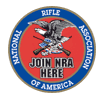
|

|
|
